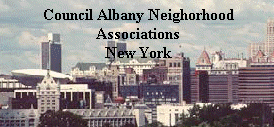Group urges action on blight
Albany -- Neighborhood leaders cite survey
in call to restore buildings
The decaying condition of buildings is the biggest
problem facing the city's neighborhoods, a group of neighborhood leaders
said Saturday.
Even if a building is abandoned, its facade should be as
well-kept as the renter-occupied brownstones and row houses surrounding it
to maintain integrity in the community, they said.
The Council of Albany Neighborhood Associations and the
Neighborhood Resource Center convened a workshop Saturday to discuss the
result of a quality-of-life survey that had been distributed in the city.
It was the first such citywide meeting the group has held in 10 years, and
while the agenda that emerged held few surprises, the gathering used the
findings and the event to plan action.
About 26,000 surveys were sent out to city residents and
1,313 were returned, said David Phaff, president of the new Albany
Neighborhood Association.
Phaff reported to the roughly 160 people attending an
afternoon session that the most pressing problem for survey respondents
citywide was upkeep of apartment buildings and two-family dwellings. About
40 percent ranked the issue as the first priority, followed by drug
dealing and winter sidewalk shoveling.
Marggie Skinner, chairwoman of the Council of Albany
Neighborhood Associations, which includes about 30 neighborhood groups,
said historic preservation is crucial to the city's future.
"There's still a tear-down-and-build-something-new
mentality instead of taking what's there and revitalizing it,'' she said.
After its 10-year hiatus, the "Neighborhoods Work''
conference was resurrected last year when Albany Roundtable President Paul
Bray brought it up at a CANA meeting. Bray, Skinner and Gene Solan, leader
of the Neighborhood Resource Center, then worked on putting together
workshops and speakers for this year's conference.
Bray had the keynote address Saturday.
"The city is at a critical juncture,'' Bray said.
"The mayor has done a good job of getting the city's act together
fiscally, but which road is it going to take -- to restore and build on
neighborhood associations, or to tear down buildings?''
The group will forward survey results to the Common
Council and mayor, Skinner said.
Common Council President Helen R. Desfosses said the
concern about the upkeep and restoration of city buildings was in line
with comments that she has heard while sitting on the council. She planned
to share the information from morning workshops -- including historic
preservation, community policing, transportation and homeownership -- with
other Common Council members.
In her closing remarks, Desfosses reinforced to those in
attendance the importance of their work on behalf of their communities.
"A neighborhood is durable but fragile,'' she said.
"A neighborhood can start to tip and it's because of the energy, and
quick response of people that we have a chance of tipping it back,''
Desfosses said.
